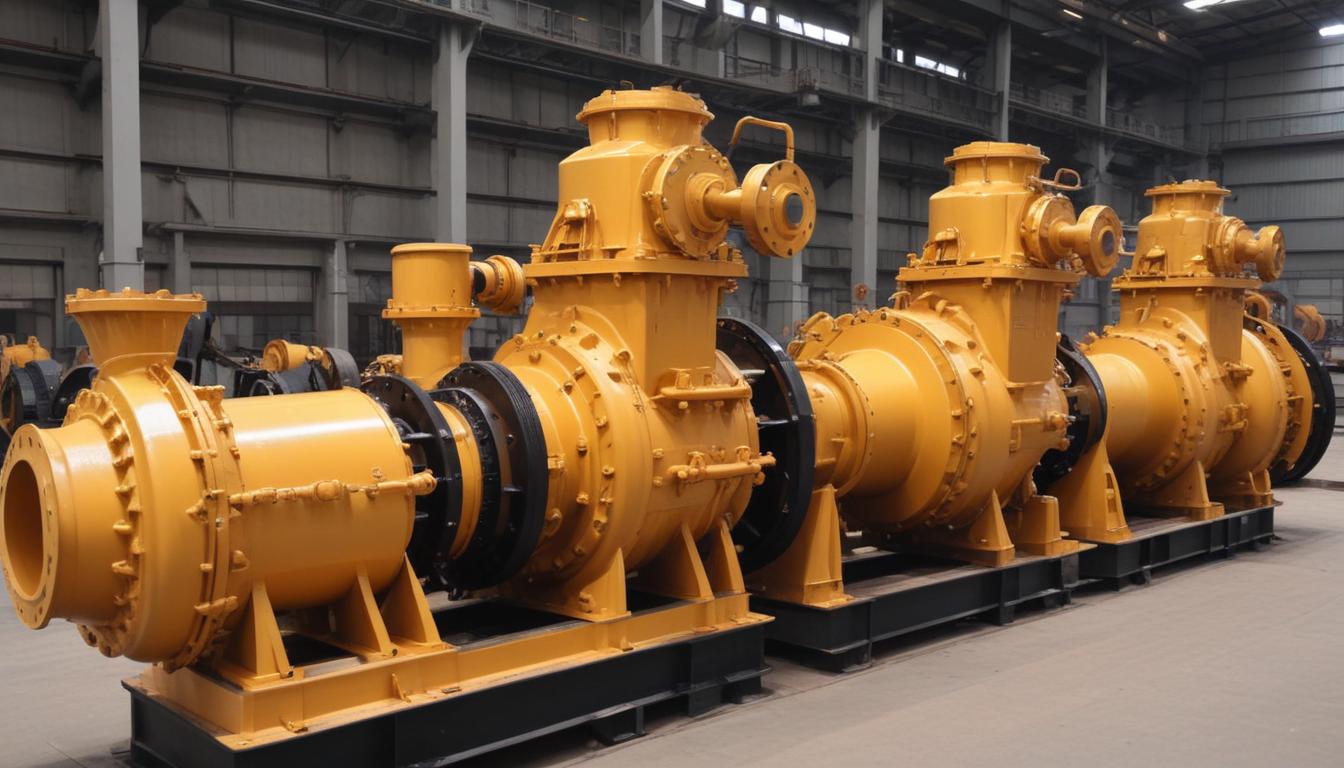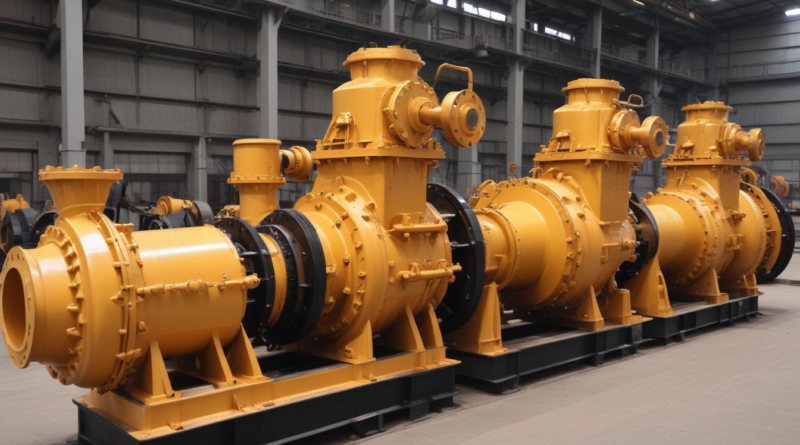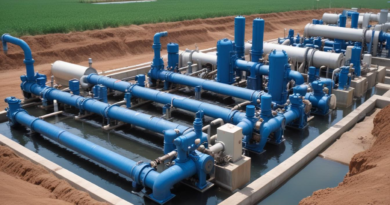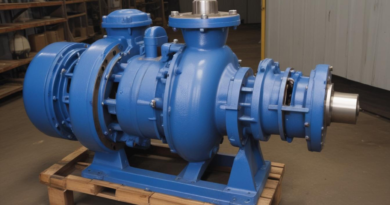pumps used in the mining sector
The mining sector utilizes a variety of specialized mining pumps designed to handle the demanding conditions and diverse applications inherent to mining operations. The primary types of pumps employed include centrifugal pumps, diaphragm pumps, submersible pumps, and progressive cavity pumps, each offering unique advantages tailored to specific operational needs.
- Centrifugal Pumps: These pumps are favored for their ability to move large volumes of water efficiently. They operate by converting rotational energy into kinetic energy through a spinning impeller, making them ideal for dewatering, slurry transport, and water circulation in mining sites.
- Diaphragm Pumps: Known for their reliability in handling abrasive and corrosive fluids, diaphragm pumps use a flexible diaphragm to create suction and discharge. They are essential in applications involving hazardous chemicals and slurry pumping where prevention of contamination is critical.
- Submersible Pumps: Designed to operate submerged in liquids, these pumps are commonly used for deep dewatering tasks, sump pumping, and removing water from mine shafts and excavations. Their sealed construction minimizes the risk of contamination and allows for efficient underwater operation.
- Progressive Cavity Pumps: These pumps excel in handling high-viscosity fluids and solid-laden slurries. Utilizing a helical rotor within a stator, progressive cavity pumps provide a steady, controlled flow, making them suitable for pumping thick mine wastewater and heavy slurries.
| Type of Pump | Key Features | Common Applications |
|---|---|---|
| Centrifugal Pumps | High flow rates, low viscosity handling | Dewatering, slurry transport, water circulation |
| Diaphragm Pumps | Handles abrasive and corrosive fluids, contamination prevention | Chemical handling, slurry pumping |
| Submersible Pumps | Operates underwater, sealed construction | Deep dewatering, sump pumping, shaft drainage |
| Progressive Cavity Pumps | Handles high-viscosity and solid-laden fluids, steady flow | Thick wastewater, heavy slurry pumping |
In addition to these primary types, the sector also employs specialized pumps such as slurry pumps for transporting abrasive mixtures, vacuum pumps for material handling, and sump pumps for managing water accumulation. The selection of the appropriate pump type is crucial to ensuring operational efficiency, reliability, and longevity within the mining environment.
selection criteria for mining pumps
Selecting the appropriate pump for mining operations involves a comprehensive evaluation of several critical factors to ensure optimal performance and longevity. Key selection criteria include:
- Flow Rate and Head Requirements: Determining the necessary flow rate and head (the height to which a pump can raise water) is essential. Mining processes vary widely, and pumps must be capable of handling the specific volumetric and pressure demands of each application.
- Fluid Characteristics: Understanding the properties of the fluid being pumped, such as viscosity, temperature, and particulate content, is crucial. Different types of mining pumps are better suited to handle specific fluid characteristics, including abrasive slurries or corrosive chemicals.
- Material Compatibility: The construction materials of the pump must be compatible with the pumped fluid to prevent corrosion and wear. Selecting materials like stainless steel, abrasion-resistant alloys, or specialized coatings can enhance pump durability and performance.
- Energy Efficiency: Energy consumption is a significant operational cost in the mining sector. Pumps with high energy efficiency ratings reduce operational expenses and contribute to more sustainable mining practices.
- Maintenance and Reliability: The ease of maintenance and the reliability of the pump are vital for minimizing downtime. Pumps designed for easy access to components and with modular parts can simplify maintenance tasks and extend the service life.
- Environmental Conditions: Mining environments can be harsh, with exposure to extreme temperatures, dust, and moisture. Pumps must be robustly designed to withstand these conditions, ensuring consistent performance and minimal environmental impact.
- Cost Considerations: The initial purchase price, installation costs, and long-term operational expenses must be evaluated. Balancing upfront costs with the total cost of ownership helps in selecting a pump that offers the best value for the specific mining application.
- Compliance and Safety Standards: Adhering to industry regulations and safety standards is mandatory. Pumps should meet all relevant certifications and be designed to ensure safe operation within the mining environment.
To facilitate the selection process, the following table outlines how different criteria align with various types of mining pumps:
| Selection Criteria | Centrifugal Pumps | Diaphragm Pumps | Submersible Pumps | Progressive Cavity Pumps |
|---|---|---|---|---|
| Flow Rate and Head | High flow rates, moderate head | Moderate flow, low to moderate head | Variable flow, high head | Low to moderate flow, steady head |
| Fluid Characteristics | Low to medium viscosity, clear liquids | Abrasive and corrosive fluids | Debris-laden and mixed fluids | High-viscosity and solid-laden slurries |
| Material Compatibility | Standard alloys, limited chemical resistance | Highly resistant materials required | Sealed and corrosion-resistant materials | Abrasion-resistant stators and rotors |
| Energy Efficiency | Generally high | Moderate | Variable based on design | Moderate to high |
| Maintenance and Reliability | Requires regular maintenance | Low maintenance, high reliability | Low maintenance when submerged | Requires periodic inspection |
| Environmental Conditions | Indoor and controlled environments | Suitable for hazardous environments | Outdoor and submerged applications | Robust for variable conditions |
| Cost Considerations | Cost-effective for high-volume needs | Higher initial cost, lower lifecycle cost | Varies with depth and capacity | Higher due to specialized components |
| Compliance and Safety | Must meet standard industry certifications | Often exceed safety requirements | Compliant with submersible operation standards | Meets stringent slurry handling regulations |
By meticulously evaluating these criteria, mining operations can select pumps that not only meet their immediate operational needs but also provide sustainable and cost-effective solutions over the long term. This strategic approach ensures that the selected mining pumps contribute to the overall efficiency and safety of mining activities.
maintenance and troubleshooting
Proper upkeep is essential to ensure the longevity and reliable performance of mining pumps within the sector. Implementing a comprehensive maintenance program not only minimizes downtime but also enhances operational efficiency and safety. Key aspects of maintenance and troubleshooting include routine inspections, timely part replacements, and prompt identification and resolution of common issues.
- Routine Inspections: Regular visual and functional inspections help in early detection of wear and tear. Inspect critical components such as impellers, seals, and bearings for signs of damage or degradation.
- Cleaning and Lubrication: Keeping pumps clean from debris and contaminants prevents blockages and reduces wear. Regular lubrication of moving parts ensures smooth operation and reduces friction, thereby extending the lifespan of the pump.
- Replacement of Wear Parts: Components like seals, gaskets, and bearings are subject to continuous stress and should be replaced according to the manufacturer’s recommendations or when signs of wear are evident.
- Monitoring Performance Metrics: Tracking parameters such as flow rate, pressure, and energy consumption can provide insights into the pump’s health and identify deviations that may indicate underlying issues.
A structured maintenance schedule is crucial for maintaining optimal pump performance. The following table outlines typical maintenance tasks along with their recommended frequencies:
| Maintenance Task | Frequency | Details |
|---|---|---|
| Visual Inspection | Daily | Check for leaks, unusual noises, and vibrations. Ensure all connections are secure. |
| Lubrication | Weekly | Lubricate bearings and moving parts to prevent excessive wear and ensure smooth operation. |
| Performance Monitoring | Monthly | Review flow rates, pressure levels, and energy consumption against baseline metrics. |
| Component Replacement | As Needed | Replace seals, gaskets, and bearings based on inspection findings and manufacturer guidelines. |
| Deep Cleaning | Quarterly | Thoroughly clean the pump casing and internal components to remove accumulated debris and prevent blockages. |
| System Calibration | Biannually | Ensure that all sensors and control systems are accurately calibrated for optimal performance. |
| Comprehensive Inspection | Annually | Conduct a detailed examination of the entire pump system, including structural integrity and alignment. |
Troubleshooting common issues promptly is vital to maintaining the efficiency and reliability of mining pumps. Below are some prevalent problems and their potential solutions:
- Pump Not Starting
- Check the power supply and ensure that the pump is receiving adequate voltage.
- Inspect for any blown fuses or tripped circuit breakers.
- Examine the motor for signs of overheating or damage.
- Low Flow Rate
- Inspect for blockages or obstructions in the intake or discharge lines.
- Check the impeller for wear or damage and replace if necessary.
- Ensure that the pump is operating at the correct speed and pressure settings.
- Excessive Vibration
- Verify that the pump is properly aligned with the motor.
- Balance the impeller to eliminate uneven weight distribution.
- Secure any loose mounting bolts or components.
- Overheating
- Check for adequate cooling and ventilation around the pump.
- Inspect the bearing lubrication and replenish if necessary.
- Ensure that the pump is not operating beyond its rated capacity.
- Unusual Noises
- Identify the source of the noise, such as loose components or debris in the pump.
- Replace damaged bearings or seals that may be causing abnormal sounds.
- Ensure that all connections are tight and secure.
Implementing predictive maintenance techniques can further enhance pump reliability. Utilizing technologies such as vibration analysis, thermal imaging, and flow monitoring allows for the early detection of potential failures, enabling proactive interventions before significant issues arise.
| Predictive Maintenance Technique | Purpose | Benefits |
|---|---|---|
| Vibration Analysis | Detect imbalances, misalignments, and bearing faults | Early identification of mechanical issues, reducing unexpected downtimes |
| Thermal Imaging | Monitor temperature variations in motor and bearings | Prevent overheating and identify electrical faults |
| Flow Monitoring | Track flow rates and pressure changes | Identify deviations from normal operation, indicating potential blockages or wear |
| Oil Analysis | Examine lubricant quality and contamination levels | Assess wear particle presence, ensuring timely lubricant replacement |
Adhering to a structured maintenance and troubleshooting regimen not only safeguards the investment in mining pumps but also ensures uninterrupted mining operations. By leveraging both routine and advanced maintenance practices, the sector can achieve enhanced pump performance, reduced operational costs, and improved overall efficiency.
applications in various mining processes
 Mining operations encompass a wide range of processes, each requiring specific pumping solutions to ensure efficiency and reliability. Various types of mining pumps play pivotal roles in these applications, addressing the unique challenges presented by different stages of mining activities. Below are some of the key applications where mining pumps are integral:
Mining operations encompass a wide range of processes, each requiring specific pumping solutions to ensure efficiency and reliability. Various types of mining pumps play pivotal roles in these applications, addressing the unique challenges presented by different stages of mining activities. Below are some of the key applications where mining pumps are integral:
- Dewatering: Removing excess water from mine sites is critical to maintaining safe and productive working environments. Centrifugal and submersible pumps are predominantly used for dewatering purposes due to their ability to handle large volumes of water efficiently. These pumps help in lowering the water table, preventing flooding, and facilitating access to underground mining areas.
- Slurry Transport: The transportation of slurry, a mixture of water and fine particles, is essential in mineral processing. Progressive cavity pumps and diaphragm pumps are ideal for this application as they can manage high-viscosity and abrasive slurries without significant wear. These pumps ensure the continuous flow of slurry to processing units, thereby maintaining the overall efficiency of the mining operation.
- Tailings Management: Managing tailings, the waste materials generated after the extraction of valuable minerals, requires robust pumping solutions. Centrifugal pumps and progressive cavity pumps are commonly employed to transport tailings from the processing plant to storage facilities. Effective tailings management is crucial for environmental compliance and the prevention of contamination.
- Groundwater Control: Controlling groundwater inflow is vital to prevent waterlogging and ensure the stability of mining structures. Submersible pumps and centrifugal pumps are utilized to manage groundwater levels, diverting water away from critical areas and maintaining the integrity of the mine shafts and tunnels.
- Chemical Handling: The handling and transportation of chemicals used in mineral processing require pumps that can resist corrosion and handle hazardous fluids. Diaphragm pumps and centrifugal pumps with specialized materials are selected for their ability to safely and efficiently move corrosive and abrasive chemicals, ensuring seamless integration into the processing workflows.
- Ventilation Systems: While not directly involved in pumping liquids, ventilation systems in mines require pumps to manage the flow of air and other gases. These pumps ensure adequate ventilation, removing harmful gases and supplying fresh air to underground workspaces, thereby maintaining a safe breathing environment for miners.
| Application | Suitable Pump Types | Key Advantages |
|---|---|---|
| Dewatering | Centrifugal Pumps, Submersible Pumps | High flow rates, efficient water removal, reliable operation in harsh conditions |
| Slurry Transport | Progressive Cavity Pumps, Diaphragm Pumps | Handles high-viscosity and abrasive materials, minimal wear and tear |
| Tailings Management | Centrifugal Pumps, Progressive Cavity Pumps | Effective waste material handling, environmental compliance |
| Groundwater Control | Submersible Pumps, Centrifugal Pumps | Prevents waterlogging, maintains mine stability |
| Chemical Handling | Diaphragm Pumps, Specialized Centrifugal Pumps | Corrosion resistance, safe handling of hazardous fluids |
| Ventilation Systems | Air Pumps, Exhaust Pumps | Ensures safe air quality, reliable airflow management |
In addition to these primary applications, mining pumps are also utilized in:
- Concentration Plants: Facilitating the movement of ore and concentrate within the processing plant, ensuring efficient material handling and processing.
- Froth Flotation Systems: Managing the circulation of water and chemicals in flotation cells, which is essential for the separation and concentration of minerals.
- Cooling and Dust Suppression: Providing cooling water for equipment and suppressing dust in mining areas to enhance safety and operational efficiency.
Mining pumps are indispensable across these various processes, each type offering specific features that cater to the demands of the sector. The integration of the right pump types ensures the seamless operation of mining activities, contributing to productivity, safety, and environmental stewardship.
advancements and innovations
Recent years have witnessed significant strides in the evolution of mining pumps, driven by the sector’s increasing demands for efficiency, reliability, and sustainability. Innovations in design, materials, and technology have fundamentally transformed the capabilities and performance of these essential components in mining operations. Below are some of the key advancements that are shaping the future of mining pumps:
- Smart Pump Technology: The integration of Internet of Things (IoT) technologies has revolutionized maintenance and operational efficiency. Smart mining pumps are equipped with sensors that monitor critical parameters such as flow rate, pressure, temperature, and vibration in real-time. This data is transmitted to centralized systems, enabling predictive maintenance, reducing unexpected downtimes, and optimizing pump performance.
- Advanced Materials: To enhance durability and resistance to abrasive and corrosive fluids, manufacturers are utilizing advanced materials and coatings. High-performance alloys, ceramic coatings, and composite materials extend the lifespan of pump components, particularly in handling harsh mining environments. These materials reduce wear and tear, minimize maintenance requirements, and ensure consistent performance.
- Energy-Efficient Designs: With energy costs being a significant concern in mining operations, there has been a strong emphasis on developing energy-efficient pump designs. Variable frequency drives (VFDs) allow for precise control of pump speeds based on demand, leading to substantial energy savings. Additionally, improvements in impeller and motor design contribute to higher efficiency and reduced power consumption.
- Modular and Scalable Systems: Modern mining pumps are increasingly designed with modularity in mind, allowing for easy scalability and customization. Modular components enable flexible configurations tailored to specific mining applications, facilitating quicker installations and upgrades. This adaptability ensures that pump systems can evolve alongside changing operational requirements.
- Enhanced Sealing Technologies: Innovations in sealing technologies have significantly improved the reliability and safety of mining pumps. Advanced seal designs prevent leaks and contamination, especially when handling hazardous or abrasive materials. These improvements not only extend the pump’s operational life but also enhance environmental safety and compliance.
- Automation and Remote Monitoring: Automation has become integral to modern mining operations, and pumps are no exception. Automated control systems enable remote monitoring and operation of pumps, reducing the need for manual intervention and enhancing operational efficiency. Remote diagnostics and control capabilities allow operators to manage pump performance from centralized control rooms, improving responsiveness and decision-making.
The following table highlights some of the prominent advancements in mining pumps and their respective benefits:
| Advancement | Description | Benefits |
|---|---|---|
| Smart Pump Technology | Integration of IoT sensors for real-time monitoring and data analysis. | Predictive maintenance, reduced downtime, optimized performance. |
| Advanced Materials | Use of high-performance alloys, ceramic coatings, and composites. | Increased durability, reduced wear, extended pump lifespan. |
| Energy-Efficient Designs | Incorporation of variable frequency drives and optimized impeller designs. | Lower energy consumption, cost savings, enhanced sustainability. |
| Modular and Scalable Systems | Designs that allow for easy customization and expansion. | Flexibility, quicker installations, future-proofing. |
| Enhanced Sealing Technologies | Advanced seals to prevent leaks and contamination. | Improved reliability, environmental safety, compliance. |
| Automation and Remote Monitoring | Automated controls and remote operation capabilities. | Operational efficiency, centralized management, rapid response. |
Another significant innovation is the development of magnetic drive pumps, which eliminate the need for traditional seals and reduce the risk of leaks. These pumps utilize magnetic coupling to transfer energy from the motor to the impeller, providing a sealed mechanism that enhances safety and minimizes maintenance needs.
3D printing has also made its mark in the manufacturing of mining pumps. Additive manufacturing allows for the creation of complex geometries and customized components that are difficult or impossible to produce using traditional methods. This technology not only accelerates the production process but also enables the rapid prototyping of new pump designs, fostering innovation and adaptability in the sector.
Furthermore, advancements in computational fluid dynamics (CFD) have improved the design and optimization of pump components. CFD simulations enable engineers to model and analyze fluid flow within pumps, leading to more efficient and effective designs. These simulations help in identifying potential performance issues and optimizing pump geometry for maximum efficiency and reliability.
Sustainable practices are also influencing pump design and operation. Manufacturers are increasingly focusing on eco-friendly materials and processes, as well as designing pumps that minimize environmental impact. Features such as low-emission motors and recyclable components are becoming standard, aligning with the sector’s broader sustainability goals.
In summary, the continual advancements and innovations in mining pumps are driving the sector towards greater efficiency, reliability, and sustainability. By embracing these technological developments, mining operations can achieve enhanced performance, reduced operational costs, and improved environmental stewardship, ensuring a robust and resilient future for the industry.




